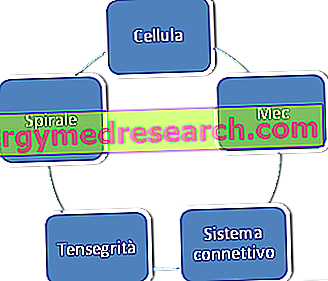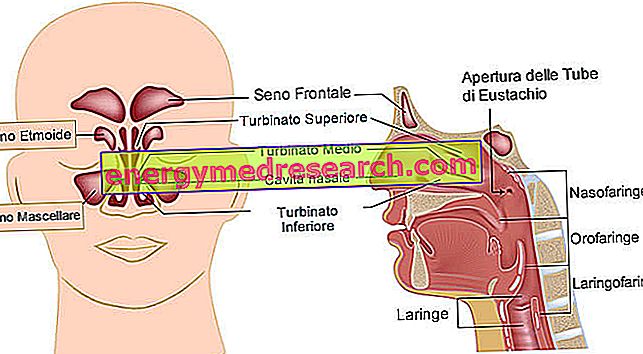Generality
Coronaviruses are a species of RNA virus, which cause respiratory infections in the upper airways (most cases) and lower ones (minority of cases).

Two types of very famous coronaviruses, since they have caused epidemics in various parts of the world in the last ten years, are SARS-Coronavirus (cause of SARS) and MERS-Coronavirus (cause of MERS).
The typical symptoms of a coronavirus infection are: runny nose, sore throat, cough, headache and fever.
There is no specific therapy, but only remedies so to speak symptomatic.
What is coronavirus?
Coronaviruses are a species of RNA virus, responsible for respiratory infections in the nasopharyngeal tract, paranasal sinuses and throat.
Together with rhinoviruses, influenza viruses and parainfluenza viruses, they are among the main cold- triggering agents.
MAIN FEATURES
Belonging, together with the toroviruses, to the viral family of the Coronaviridae, the coronaviruses are capsulated (that is, enveloped) viruses with helical symmetry, ranging in size from 80 to 160 nm.
The genome (or genetic material) of the coronavirus RNA is single-stranded and can range in size from 26 to 32 kilobases.
Among RNA viruses, coronaviruses are the viral agents with the largest genome.
Most famous "Coronavirus":
- Alpha coronavirus 229E
- Alpha coronavirus NL63
- Beta coronavirus OC43
- Beta coronavirus HKU1
- Beta coronavirus SARS Co-V
- Beta coronavirus MERS Co-V
ORIGIN OF THE NAME
The coronaviruses owe their name to the fact that, under the electron microscope, they appear as a sort of fringed bulb, which is very reminiscent of a royal crown or the solar corona.
To constitute the fringe that surrounds the bulb - which is the viral element within which the RNA genome resides - are the peplomers, protein structures necessary for tropism (ie movement).
The term "coronavirus" is the result of the union of the Latin word "corona" - which in Italian means "crown" or "halo" - and of the word virus.
HISTORY
The first description of coronaviruses dates back to 1960, after some researchers had considered some cases of colds.
Between 2002 and 2003, coronaviruses rose to prominence in the news following the SARS epidemic, which broke out at that time. SARS - an acronym that means Severe Acute Respiratory Syndrome - is a very powerful upper and lower respiratory tract infection caused by a coronavirus whose specific name is SARS-CoV (or SARS-Coronavirus ).
Curiously, ten years after the SARS epidemic, another coronavirus became famous for triggering another epidemic of a very strong respiratory disease: the so-called MERS or Middle-Eastern Respiratory Syndrome .
The trigger agent for MERS is the coronavirus known as MERS-CoV (or MERS-Coronavirus ).
Epidemiology
Coronaviruses are widespread viruses in the human population and, except in special cases (such as in the case of SARS or MERS), do not raise particular concerns.
According to a survey on the viral causes of colds, coronaviruses would be responsible for about 10-15% of cases of cold found in the general population.
It is highly probable that many of us, without knowing it, have contracted, even more than once in their life, some coronavirus infection.
Transmission
The transmission of coronaviruses in the human population occurs mainly in two ways:
- Through the inhalation of volatile droplets emitted by people infected by the virus, when they speak, sneeze, cough or breathe.
This mode of transmission is the most common and the one that causes the most infections.
- Through physical contact with contaminated hands, surfaces, food or objects.
For example, it can be decisive: to touch buttons, telephones, handles or toilets, or to share crockery, cutlery etc.
SARS transmission method:
direct:
- Volatile droplets due to sneezing, coughing, breathing etc.
indirect:
- Contact with contaminated objects (telephones, computer keyboards, etc.).
- Contact with a patient's organic fluids (faeces).
RISK FACTORS
In general, coronavirus infections are more likely during the autumn or winter season . However, it is good to remember that coronaviruses can infect humans all the time of the year.
Another risk factor that strongly affects the possibility of developing a coronavirus infection is the close proximity to a contaminated individual.
Symptoms
The symptoms and signs induced by coronaviruses are the symptoms caused by the most common respiratory infections, namely:
- Closed and runny nose
- Cough
- Sore throat
- Fever between 38 ° C and 39 ° C
- Inflammation of nasal mucous membranes, throat and bronchi
- Headache
- Loss of appetite
- Sense of general malaise
In general, coronavirus infections involve the upper respiratory tract (from the mouth and nose to the excluded trachea). However, it is not excluded that the viral infectious agent can also reach the lower respiratory tract (from the trachea to the lungs) and cause bronchitis or pneumonia .
The risk of coronavirus pneumonia is greater in elderly people, in patients with heart disease and in people with weak immune systems.
Diagnosis
To know the precise type of coronavirus that has infected an individual, some laboratory tests on blood and nose-pharyngeal swabs are needed.
However, it should be pointed out that the realization of such tests takes place only if there are particular reasons. Normally, in fact, doctors rely only on physical examination, followed by anamnesis (or medical history).
Treatment
Premise: there is no specific treatment against coronaviruses and the infections they cause.
In general, doctors recommend a healthy patient with a coronavirus infection:
- Stand at complete rest until the symptoms disappear.
- Drink plenty of fluids (rehydration), to avoid dehydration.
- Take anti-inflammatory and analgesic drugs against sore throats and fever. Among the most used drugs are ibuprofen, paracetamol and aspirin (NB: remember that aspirin is absolutely contraindicated for people under the age of 16 due to the danger of Reye's syndrome).
REHYDRATION: WHAT IS IT?
Usually, the rehydration of a person with a coronavirus infection consists of taking water-based liquids, mineral salts and a few sugars.
Prevention
There is no coronavirus vaccine.
However, there are useful remedies that effectively reduce the risk of infection.
These remedies include:
- Hand washing with soap and hot water or with alcohol-based solutions, specifically designed to not irritate the skin.
- If you are unable to wash your hands, keep your fingers away from your eyes, nose and mouth.
- Avoid contact with people contaminated with coronavirus as much as possible.
HOW TO AVOID CONTAMINATING OTHER PEOPLE
Stay at home until the end of the infection, avoid contact with other people, cover your mouth and nose with a tissue at every sneeze or cough (and of course throw the tissue immediately afterwards), take care to disinfect the objects and the most touched and affordable surfaces for all: these are the main tricks that a person with a coronavirus infection must follow, to avoid contaminating someone else.



